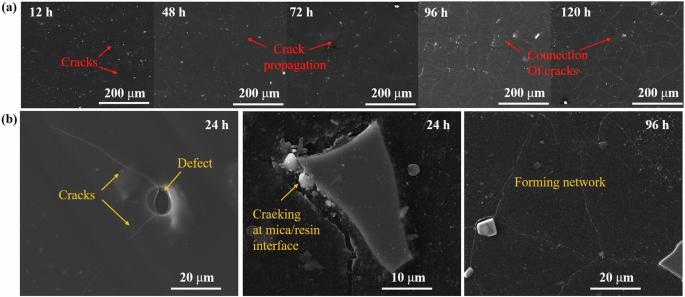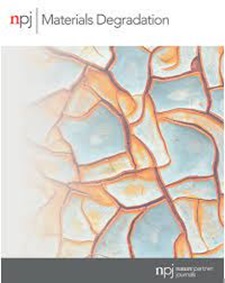Lifetime prediction of epoxy coating using convolutional neural networks and post processing image recognition methods
IF 7.6
2区 材料科学
Q1 MATERIALS SCIENCE, MULTIDISCIPLINARY
引用次数: 0
Abstract
The rapid failure of organic coatings in deep-sea environments complicates accurate lifetime prediction. Given the rapid cracking characteristic on the coating surface in this environment, a comprehensive “performance-structure” failure model was established. Initially, a targeted image recognition approach containing convolutional neural network (CNN) and post-processing was constructed for the crack area detection. An overall precision of 82.81% demonstrated the network’s good accuracy. The length distribution and the statistical evolution of cracks were extracted from SEM images to obtain the kinetic equation of the cracks related to coating structure degradation. In addition, the kinetics of water diffusion and coating adhesion were examined, as they represent critical parameters of coating performance. Based on this achievement, a failure model incorporating three dominant factors was integrated by the gray relational analysis method. The average prediction error of the model was 2.60%, which lays the groundwork for developing image-based methods to predict coating life.

利用卷积神经网络和后处理图像识别方法预测环氧树脂涂层的寿命
有机涂层在深海环境中的快速失效使得准确预测使用寿命变得复杂。鉴于涂层表面在这种环境下的快速开裂特征,建立了一个全面的 "性能-结构 "失效模型。首先,构建了一种包含卷积神经网络(CNN)和后处理的目标图像识别方法,用于裂纹区域检测。82.81% 的总体精度证明了该网络的良好准确性。从 SEM 图像中提取了裂纹的长度分布和统计演化,从而获得了与涂层结构退化相关的裂纹动力学方程。此外,还研究了水扩散动力学和涂层附着力,因为它们代表了涂层性能的关键参数。在此基础上,利用灰色关系分析方法整合了包含三个主导因素的失效模型。该模型的平均预测误差为 2.60%,为开发基于图像的涂层寿命预测方法奠定了基础。
本文章由计算机程序翻译,如有差异,请以英文原文为准。
求助全文
约1分钟内获得全文
求助全文
来源期刊

npj Materials Degradation
MATERIALS SCIENCE, MULTIDISCIPLINARY-
CiteScore
7.80
自引率
7.80%
发文量
86
审稿时长
6 weeks
期刊介绍:
npj Materials Degradation considers basic and applied research that explores all aspects of the degradation of metallic and non-metallic materials. The journal broadly defines ‘materials degradation’ as a reduction in the ability of a material to perform its task in-service as a result of environmental exposure.
The journal covers a broad range of topics including but not limited to:
-Degradation of metals, glasses, minerals, polymers, ceramics, cements and composites in natural and engineered environments, as a result of various stimuli
-Computational and experimental studies of degradation mechanisms and kinetics
-Characterization of degradation by traditional and emerging techniques
-New approaches and technologies for enhancing resistance to degradation
-Inspection and monitoring techniques for materials in-service, such as sensing technologies
 求助内容:
求助内容: 应助结果提醒方式:
应助结果提醒方式:


